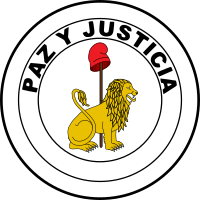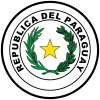
The Great Seal is a principal national symbol of the United States. The phrase is used both for the physical seal itself, which is kept by the United States Secretary of State, and more generally for the design impressed upon it. The obverse of the Great Seal depicts the national coat of arms of the United States while the reverse features an unfinished pyramid topped by an Eye of Providence. The year of the U.S. Declaration of Independence, 1776, is noted in Roman numerals at the base of the pyramid. The seal contains three Latin phrases: E Pluribus Unum, Annuit cœptis, and Novus ordo seclorum.

The coat of arms of the Philippines features the eight-rayed sun of the Philippines with each ray representing the eight provinces which were placed under martial law by Governor-General Ramón Blanco Sr. during the Philippine Revolution, and the three five-pointed stars representing the three major island groups of Luzon, the Visayas, and Mindanao.

The national flag of the Republic of Moldova is a vertical triband of blue, yellow, and red, charged with the coat of arms of Moldova on the centre bar. The reverse is mirrored. The flag ratio is 1:2. Until further provisions, the State Flag of Moldova is used as the national flag and ensign as well; that is, civil, state and war flag and ensign.

The coat of arms of the Argentine Republic or Argentine shield was established in its current form in 1944, but has its origins in the seal of the General Constituent Assembly of 1813. It is supposed that it was chosen quickly because of the existence of a decree signed on February 22 sealed with the symbol. The first mention of it in a public document dates to March 12 of that same year, in which it is stated that the seal had to be used by the executive power, that is, the second triumvirate. On April 13 the National Assembly coined the new silver and gold coins, each with the seal of the assembly on the reverse, and on April 27 the coat of arms became a national emblem. Although the coat of arms is not currently shown on flags, the Buenos Aires-born military leader Manuel Belgrano ordered to paint it over the flag he gave to the city of San Salvador de Jujuy, and during the Argentine War of Independence most flags had the coat of arms.

The coat of arms of Belgium bears a lion or, known as Leo Belgicus, as its charge. This is in accordance with article 193 of the Belgian Constitution: The Belgian nation takes red, yellow and black as colours, and as state coat of arms the Belgian lion with the motto UNITY MAKES STRENGTH. A royal decree of 17 March 1837 determines the achievement to be used in the greater and the lesser version, respectively.

The flag of El Salvador features a horizontal triband of cobalt blue-white-cobalt blue, with the coat of arms centered and entirely contained within the central white stripe. This design of a triband of blue-white-blue is commonly used among Central American countries. Along with the Dominican Republic, Ecuador and Haiti, it is one of only four national flags which has a depiction of its flag within the flag itself. El Salvador's flag is one of few that currently use the color purple, due the rainbow in its Coat of Arms.
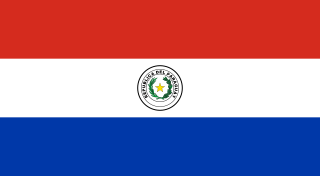
The flag of Paraguay was first adopted in 1842. Its design, a red–white–blue triband, was inspired by the colours of the French Tricolour, believed to signify independence and liberty. The flag is unusual because it differs on its obverse and reverse sides: the obverse of the flag shows the national coat of arms, and the reverse shows the seal of the treasury. It is one of only three national flags worldwide which bears this feature, the others being from Moldova and Saudi Arabia. The flag consists of the same three horizontal colours as the flag of the Netherlands, which in turn was the inspiration of the French flag. It was revised in 2013 to bring the flag towards its original design. It has a ratio of 11:20.

The coat of arms of Bulgaria consists of a crowned golden lion rampant over a dark red shield; above the shield is the Bulgarian historical crown. The shield is supported by two crowned golden lions rampant; below the shield there is compartment in the shape of oak twigs and white bands with the national motto "Unity makes strength" inscribed on them.

The coat of arms of Chile dates from 1834 and was designed by the English artist Charles Wood Taylor (1792–1856). It is made up by a figurative background divided in two equal parts: the top one is blue and the bottom, red. A five pointed white star is in the centre of the shield. This background is supported in one side by a condor, the most significant bird of prey from the Andes, and in the other, by a huemul, a mammal endemic to Chile. Both animals wear golden naval crowns symbolising the heroic deeds of the Chilean Navy in the Pacific Ocean.
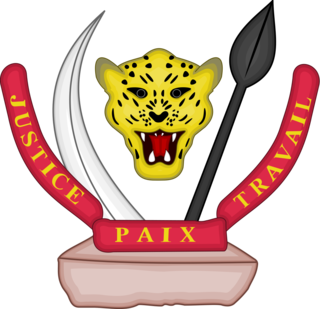
The national emblem of the Democratic Republic of the Congo has changed several times since 1997. The current one was introduced in 2006 and depicts a leopard head, surrounded by an elephant tusk to the left and a spear to the right. Below are the three words which make up the national motto: Justice, Paix, Travail. It was adopted on 18 February 2006 by President Joseph Kabila.

The official coat of arms of the Republic of Costa Rica was designed in 1848, with modifications in 1906, 1964, and 1998. The latest change was the addition of smoke to distinguish the three volcanoes.

The flag of West Virginia is the official flag of the U.S. State of West Virginia and was officially adopted by the West Virginia Legislature on March 7, 1929. The present flag consists of a pure white field bordered by a blue stripe with the coat of arms of West Virginia in the center, wreathed by Rhododendron maximum and topped by an unfurled red ribbon reading, "State of West Virginia." It is the only state flag to bear crossing rifles, meant to illustrate the importance of the state's fight for liberty during the Civil War as the southern unionist 35th state.

In military organizations, the practice of carrying colours, standards, flags, or guidons, both to act as a rallying point for troops and to mark the location of the commander, is thought to have originated in Ancient Egypt some 5,000 years ago. The Roman Empire also made battle standards, reading SPQR a part of their vast armies. It was formalized in the armies of Europe in the High Middle Ages, with standards being emblazoned with the commander's coat of arms.

The following is a list of historical military colours, standards and guidons in different countries that do not exist today.

The Seal of the Commonwealth of Virginia is the official seal of the Commonwealth of Virginia, a U.S. state. The state flag of Virginia consists of the obverse of the seal against a blue background. A state flag was first adopted at the beginning of the American Civil War in April 1861, readopted in 1912, and standardized by the General Assembly in February 1950. The standing allegorical female figure of virtue is shown having vanquished tyranny, symbolized by a fallen king at her feet. She has an exposed breast in the manner of classical depictions of Amazons, making this the only state flag in the U.S. depicting a form of nudity. The motto, "Sic semper tyrannis," means "Thus always to tyrants." The flag may be decorated with a white fringe along the fly edge; this is usually done when the flag is displayed indoors.

The Great Seal of the State of Maryland is the official government emblem of the U.S. state of Maryland. Its official service is to authenticate acts by the General Assembly of Maryland, but it is also used for display purposes at most state buildings. Although the state seal has been changed in design several times throughout history, the current model represents the reverse side of the original seal.

The Seal of the State of Texas was adopted through the 1845 Texas Constitution, and was based on the seal of the Republic of Texas, which dates from January 25, 1839.
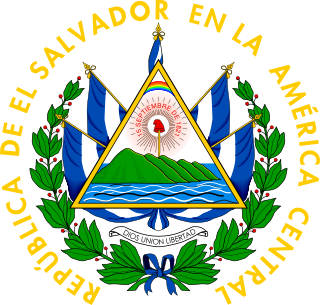
The coat of arms of El Salvador has been in use in its current form since 15 September 1912.

The coat of arms of Singapore is the heraldic symbol representing the sovereign island country and city-state of Singapore located in maritime Southeast Asia. It was adopted in 1959, the year Singapore attained self-governance from the British Empire, and remains in use after its independence in 1965. The committee that created it, headed by Toh Chin Chye, who was also responsible for the national flag and the national anthem of Singapore.
A national coat of arms is a symbol which denotes an independent state in the form of a heraldic achievement. While a national flag is usually used by the population at large and is flown outside and on ships, a national coat of arms is normally considered a symbol of the government or the head of state personally and tends to be used in print, on armorial ware, and as a wall decoration in official buildings. The royal arms of a monarchy, which may be identical to the national arms, are sometimes described as arms of dominion or arms of sovereignty.

